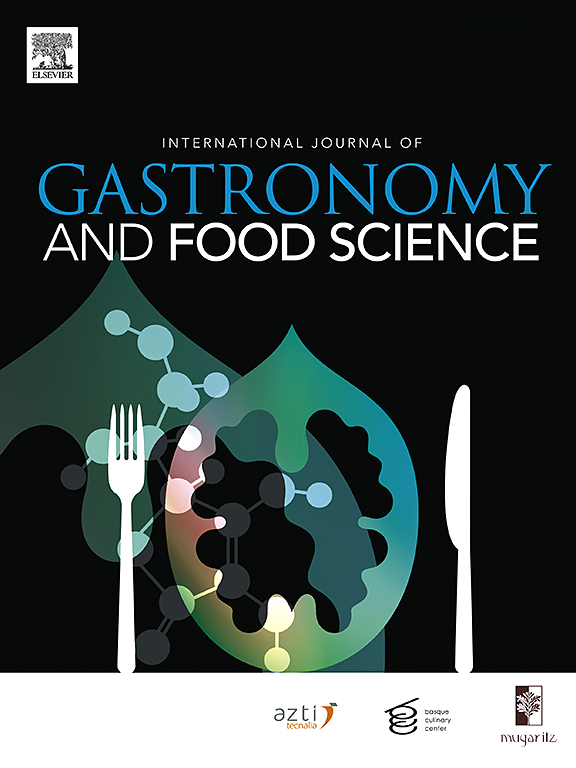马尼拉罗望子分离蛋白冻融法制备肉类类似物的成分优化
IF 3.2
2区 农林科学
Q2 FOOD SCIENCE & TECHNOLOGY
International Journal of Gastronomy and Food Science
Pub Date : 2024-12-30
DOI:10.1016/j.ijgfs.2024.101095
引用次数: 0
摘要
本研究以马尼拉罗望子蛋白为原料,通过优化不同组分的组成,获得所需的结构属性和理化属性,制备出具有纹理化特性的蛋白。采用d -最优混合设计,通过混合组分(固体和液体)的组合得到理想的配方。通过冷冻织构过程产生所需的织构。研究了硬度、弹性、纤维和蛋白质含量的响应。不同成分的最佳添加量分别为分离蛋白6.53%、小麦面筋1.23%、菠萝蜜粉1.15%、海藻酸钠3.6%、液体(水油比10:1)87.48%。预测值和实验值在几乎所有情况下都具有可比性,优化后的方法可用于开发具有所需质地和营养属性的构化蛋白。织构蛋白的垂直切削力为684.9 g (6.85 N),平行切削力为972.55 g (9.72 N),织构度值为1.42。优化后的构化蛋白蒸煮得率和蒸煮损失分别为86.33%和13.67%,体外消化率为64.33%。扫描电镜结果表明,冷冻织构蛋白呈层状结构,纤维尺寸在10 ~ 100 μm之间。本文章由计算机程序翻译,如有差异,请以英文原文为准。
Optimization of ingredient composition for meat analogue prepared from Manila tamarind protein isolate by freeze texturization
In this study, Manila tamarind seed protein was used to produce texturized protein by optimizing the composition of different components to achieve desired structural and physicochemical attributes. D-optimal mixture design was used to obtain the desired formulation by combination of the mixture components (solids and liquid). The desired texture was produced through the freeze-texturization process. The responses studied were hardness, springiness, fibre, and protein content. The optimized dosages of different constituents were calculated as protein isolate at 6.53%, wheat gluten at 1.23%, jackfruit flour at 1.15%, sodium alginate at 3.6% and liquid (water and oil, 10:1) at 87.48%. Predicted and experimental values were comparable in almost every case and the optimized methodology can be used to develop texturized proteins of desired textural and nutritional attributes. The vertical cutting force and parallel cutting force of the texturized protein was 684.9 g (6.85 N) and 972.55 g (9.72 N), respectively, giving degree of texturization value as 1.42. The cooking-yield and cooking-loss of the optimized texturized-protein was 86.33% and 13.67%, respectively, while the in-vitro protein digestibility value was 64.33%. The scanning electron micrographs showed that the layered structure was observed for freeze-texturized proteins, with fiber size ranging between 10 and 100 μm.
求助全文
通过发布文献求助,成功后即可免费获取论文全文。
去求助
来源期刊

International Journal of Gastronomy and Food Science
Social Sciences-Cultural Studies
CiteScore
5.30
自引率
10.50%
发文量
170
审稿时长
45 days
期刊介绍:
International Journal of Gastronomy and Food Science is a peer-reviewed journal that explicitly focuses on the interface of food science and gastronomy. Articles focusing only on food science will not be considered. This journal equally encourages both scientists and chefs to publish original scientific papers, review articles and original culinary works. We seek articles with clear evidence of this interaction. From a scientific perspective, this publication aims to become the home for research from the whole community of food science and gastronomy.
IJGFS explores all aspects related to the growing field of the interaction of gastronomy and food science, in areas such as food chemistry, food technology and culinary techniques, food microbiology, genetics, sensory science, neuroscience, psychology, culinary concepts, culinary trends, and gastronomic experience (all the elements that contribute to the appreciation and enjoyment of the meal. Also relevant is research on science-based educational programs in gastronomy, anthropology, gastronomic history and food sociology. All these areas of knowledge are crucial to gastronomy, as they contribute to a better understanding of this broad term and its practical implications for science and society.
 求助内容:
求助内容: 应助结果提醒方式:
应助结果提醒方式:


